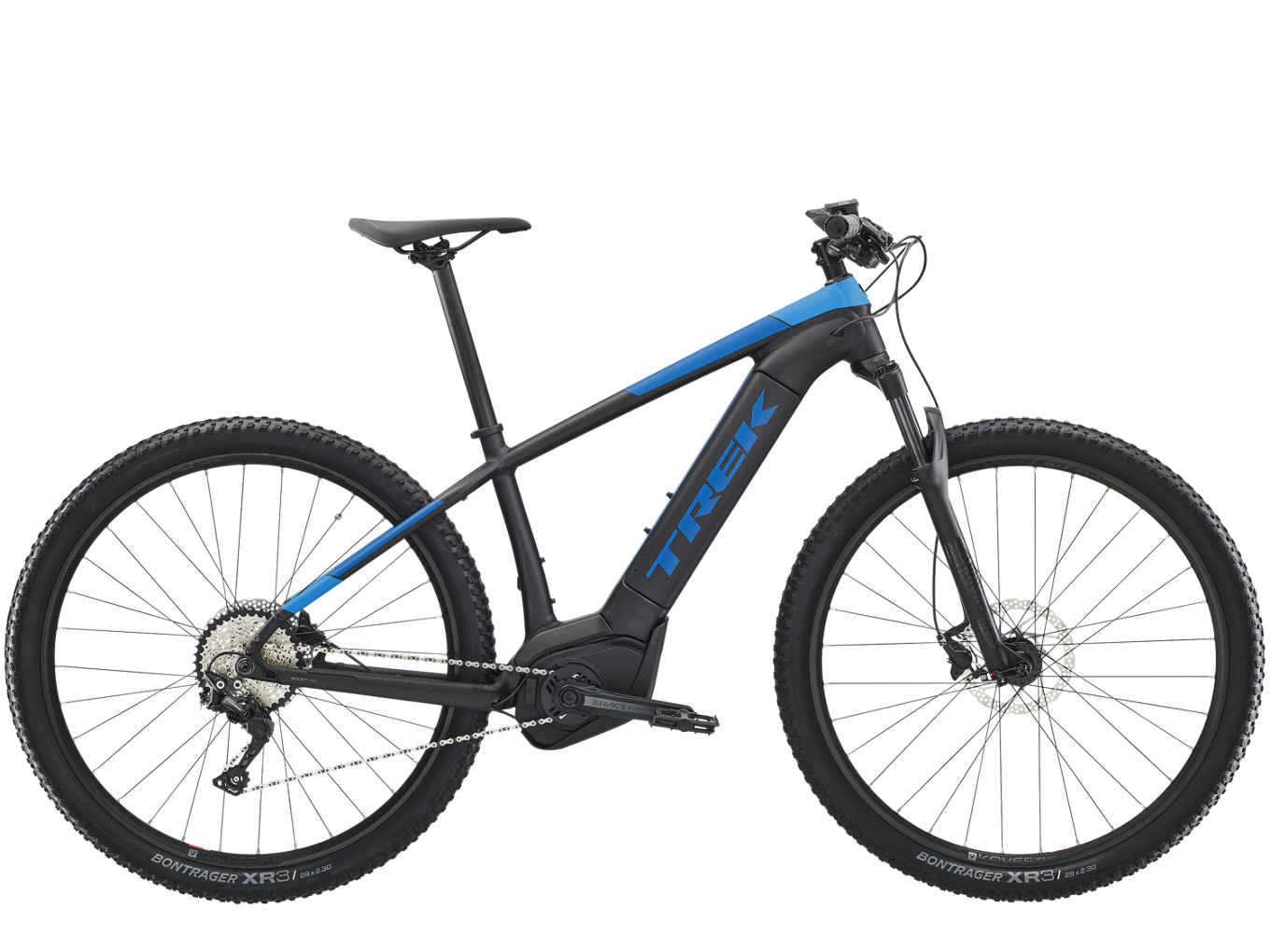Joergen8
Active Member
So here are some FLIR One infrared imaging photos of my EVO 29er 2015. Maybe this will be of interest to some people, as there have been some questions about the usefulness of neoprene or custom battery covers/jackets.
UPDATED with official BH Easy Motion neoprene Winter Cover measurements:
I've now had the official BH neoprene winter cover for a few months, and here are some results. I've formatted the pictures to be more at-a-glance instead of uploading each FLIR photo individually.
Background for each result:
-Typically 12km (7.5mi) / 30min commute ride, charging right before riding.
-Bike inside before ride, either room temp or lower garage temp.
-Boost or Sport mode (max assist level, 250W Controller, 350W US-spec motor).
-Official BH Winter Cover on during charging and riding, only taking it off to measure battery surface temperature.
The results are far better than I expected. The neoprene cover performs excellently under conditions where the battery is drained quickly and the resulting current draw / resistive discharge heat together with the stored ambient heat is preserved, but the battery still doesn't seem to reach harmful temperatures either. The resulting battery temperature does seem to correlate with outside ambient temperature, but not nearly as dramatically as I expected. The end result between +2 deg C and -19 deg C weather is only 4 degrees C in battery temperature (37 deg F differential yields 10 deg F variance).
Charging with the cover on at room temperature and at 2 Amperes (36V) is perfectly safe, only a minor difference between ambient and battery temperature can be (superficially) observed after hours of charging. So there's no need to take the cover off at all during the winter months, except for washing the bike or to remove the battery.
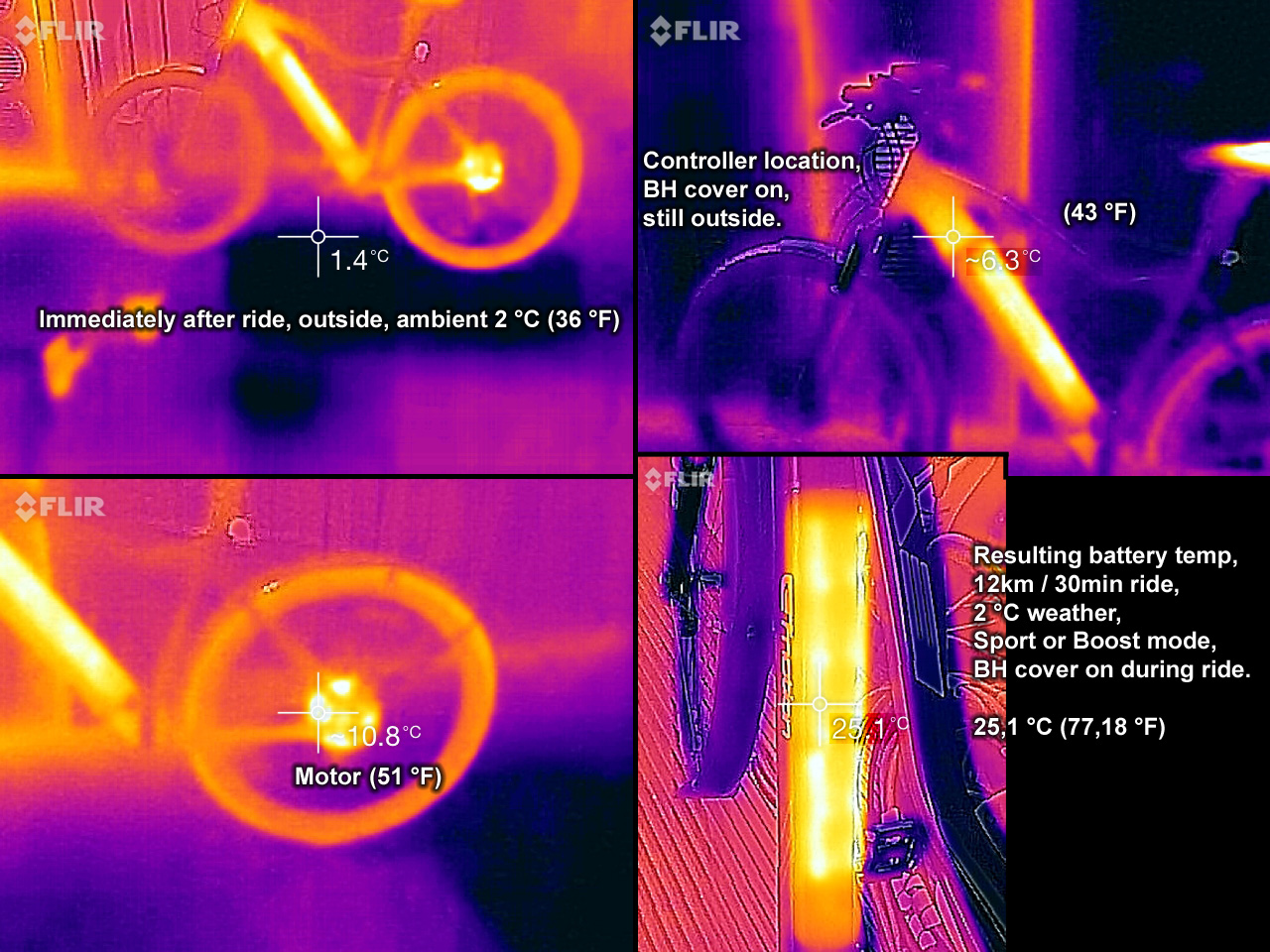
20th Oct 2016
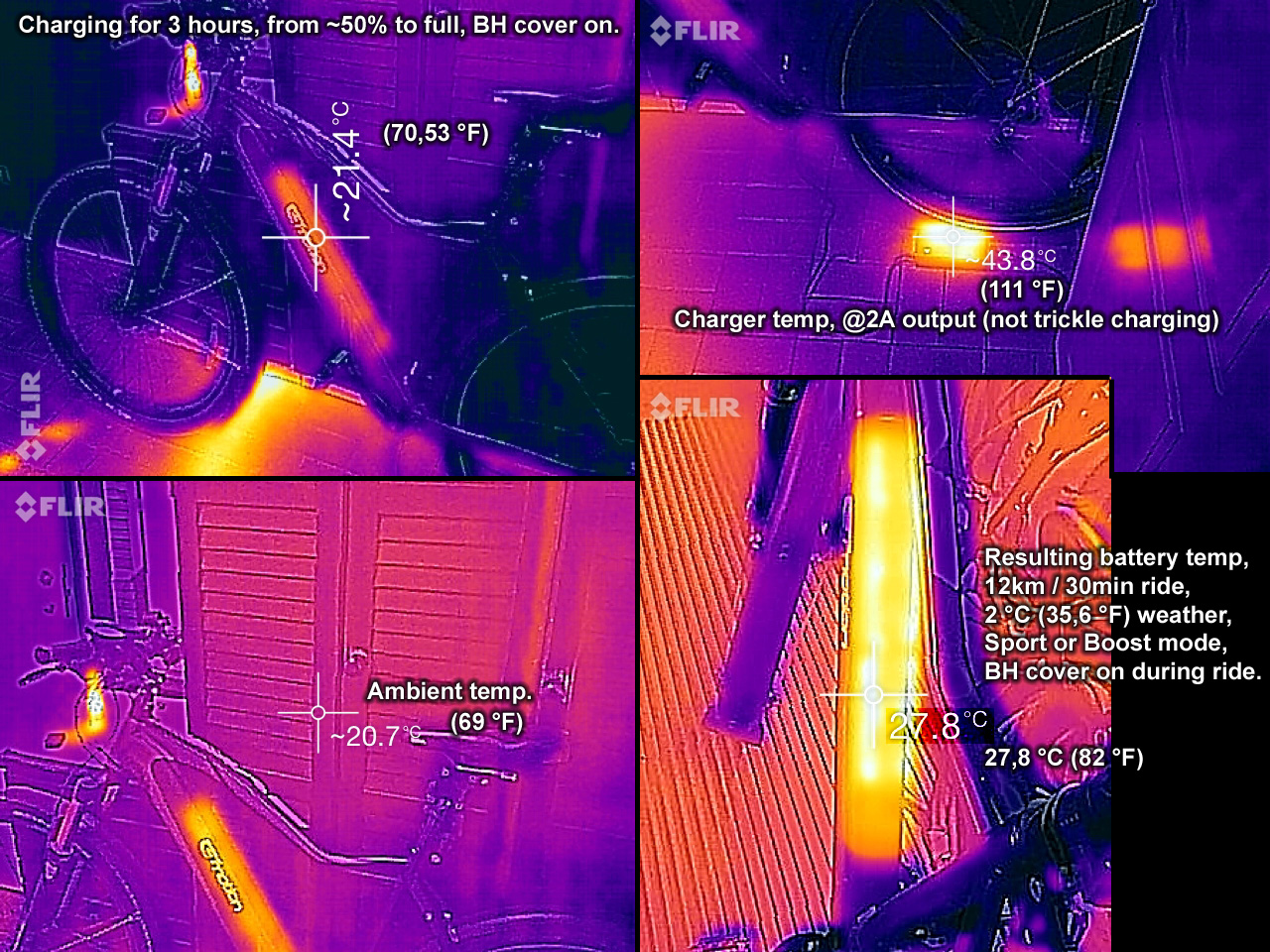
21st Oct 2016
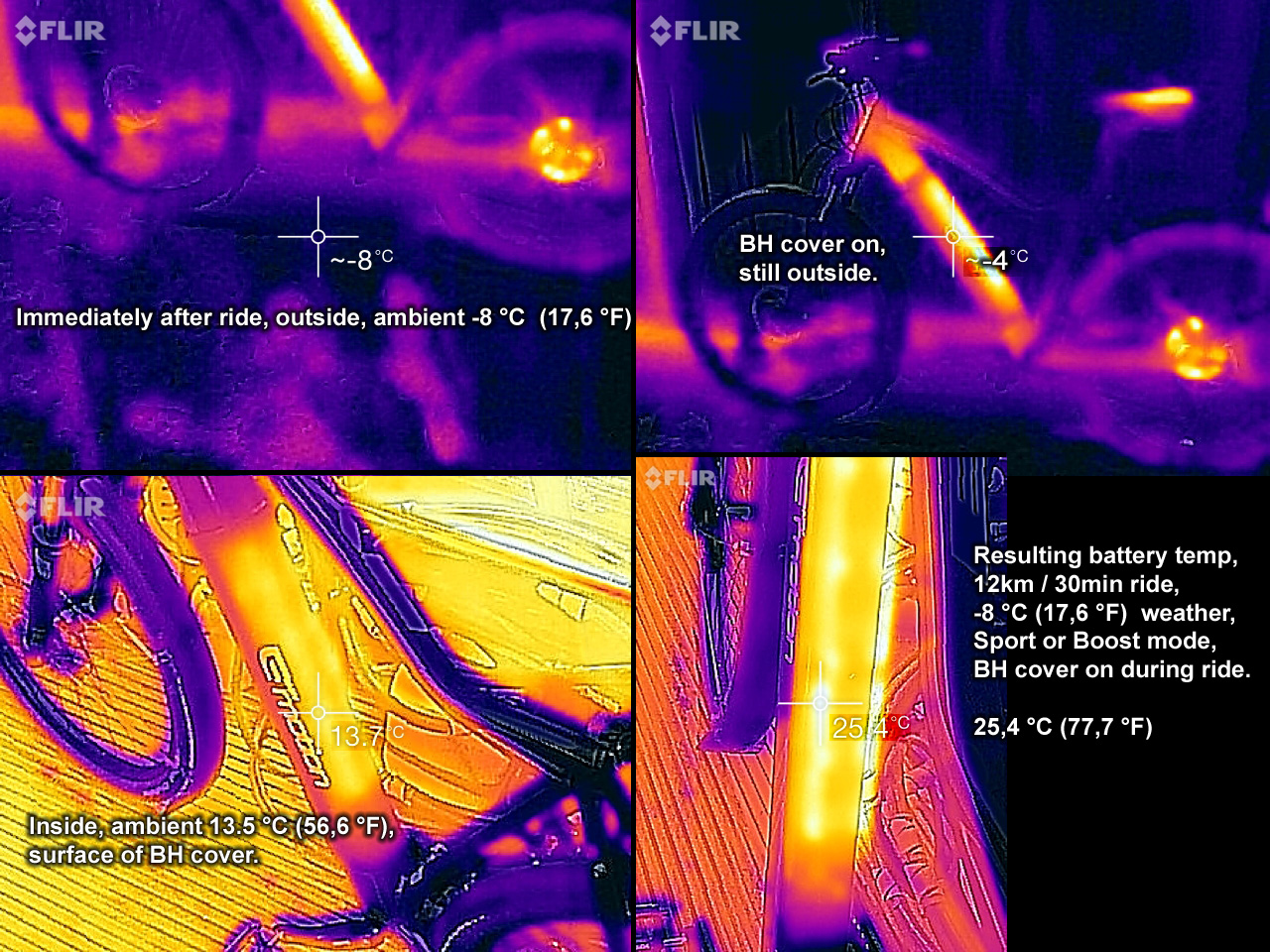
7th November 2016
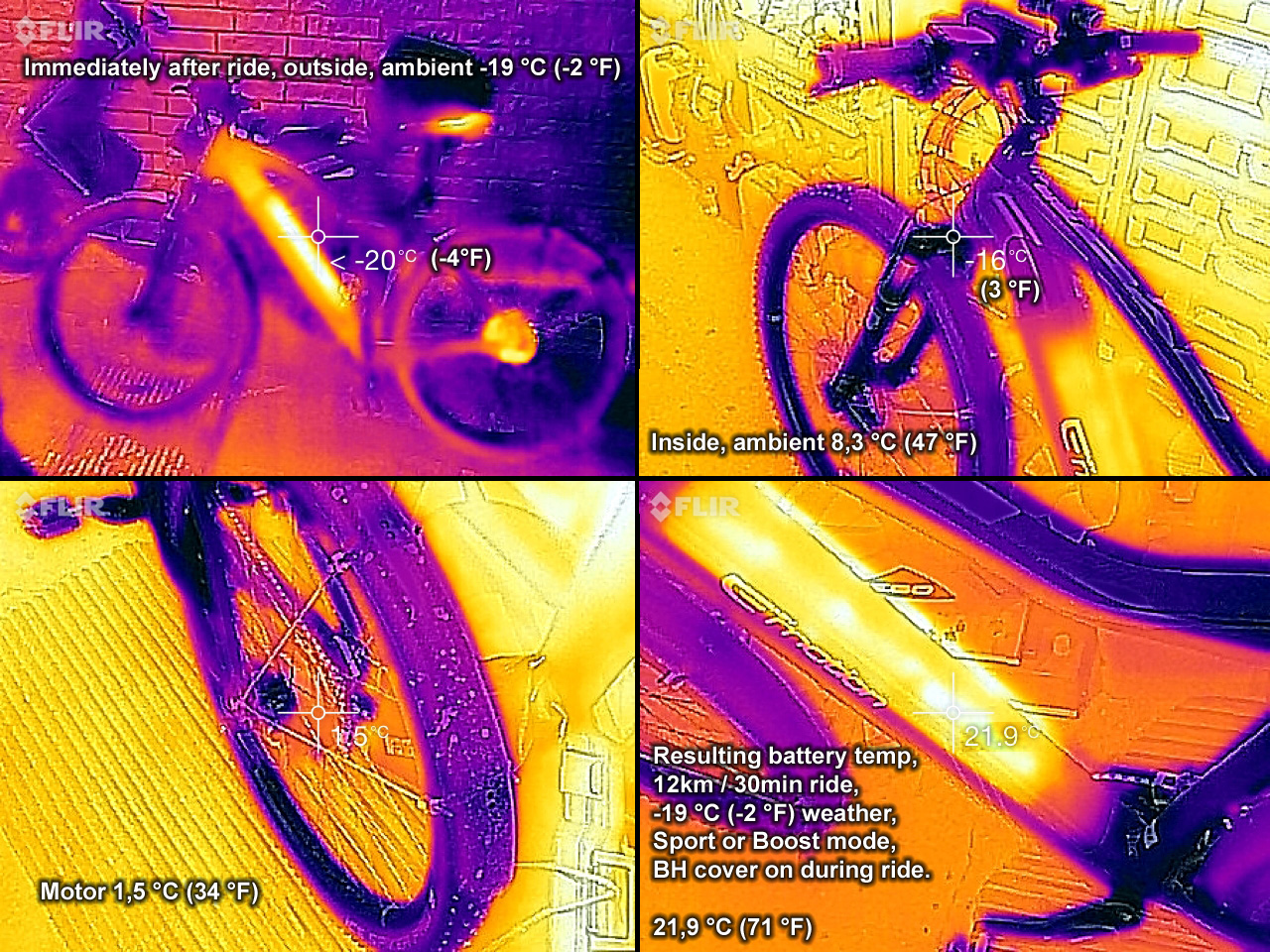
7th January 2017
----------------------------------------------
Older CUSTOM cover measurements:
Using my custom 13mm Armacell cover, +3 deg C weather, 7km trip. Starting temp (ambient) of the bike was about 15 C. Battery at full charge, not charged for two days (so NO residual charging heat or gain). "Sport" assist. After the ride:
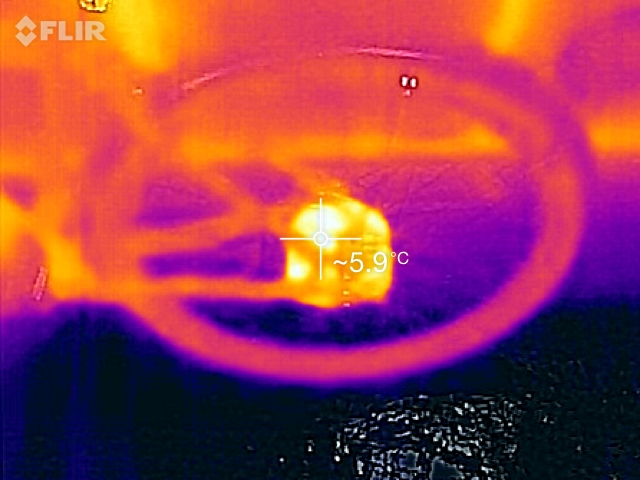
Motor temp immediately after ride, outdoor pic. For reference, the bike frame and wheel should be around +4 C here, and the ground is subzero (actually ice). Reading might be inaccurate.
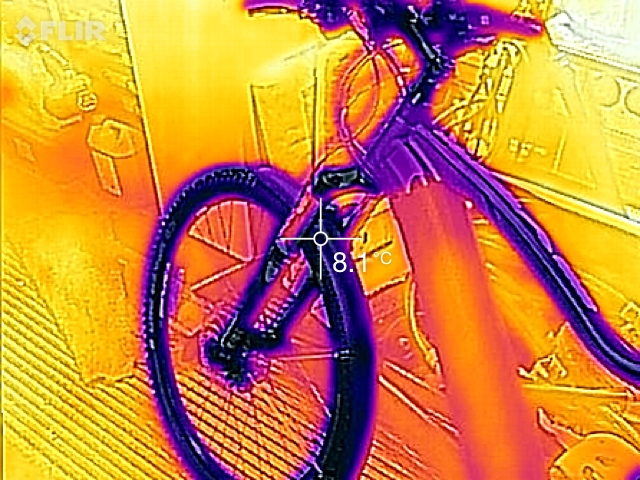
A minute later, bike indoors, cover still on, warming up towards ambient temp (15C). Fenders are matted plastic just like the battery, for emissivity, scale and reference. Though this won't be an exact science.
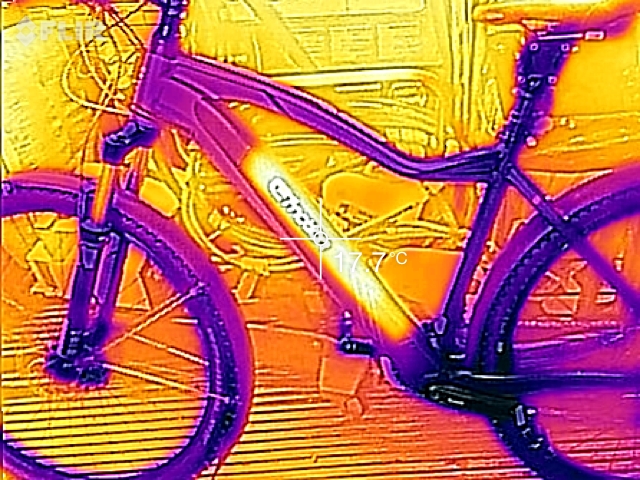
Cover off, battery temp (gain?) 17.7 C, clearly warmer than ambient. Notice how the underside of the alloy downtube has transferred the outdoor ambient temp almost uniformly down the frame, despite the thick protective cover. So the downtube is a bit of a heatsink for the battery, though the rubber pads on the battery and the gap between the battery shell and the bike frame should help isolate the battery from the cooler frame.
-----------------------------
I let the bike reach ambient temp again between rides. Second ride just like the first (+3C and 7km, Sport assist), but this time without the cover:
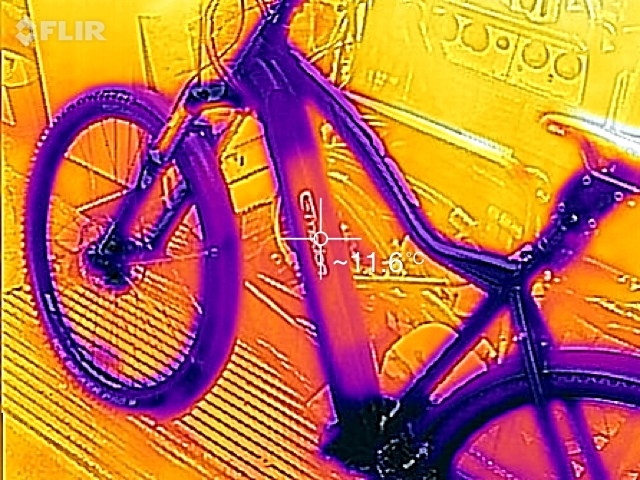
Battery temp much lower. Readings not super accurate due to lack of calibration cycles. Battery temp mostly residual indoor thermal energy due to battery mass and short ride, not as much resistive heat? Notice colder section towards the lower end of the battery, this houses the battery management system (BMS) board and circuitry, so mostly empty space, the groups of 18650 cells are above it.
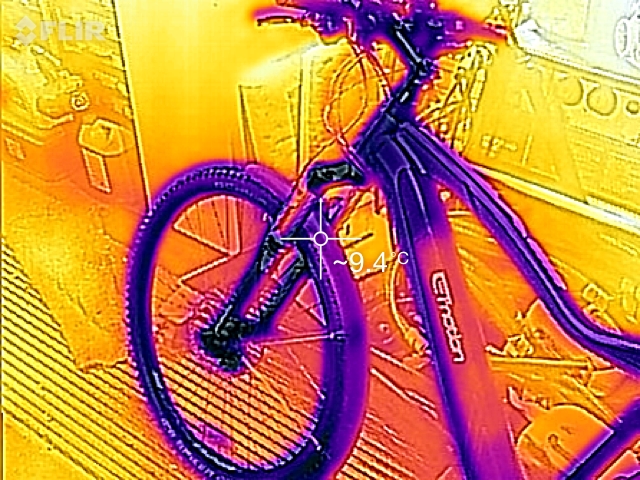
Reticle on plastic fenders, for reference.
-----------------------------------
UPDATE: Second day of testing.
I wanted to see if it's bad for the battery to keep the 13mm cover on while charging, causing it to overheat. Keep in mind, the official cover would only be 3mm neoprene, so way less insulation.
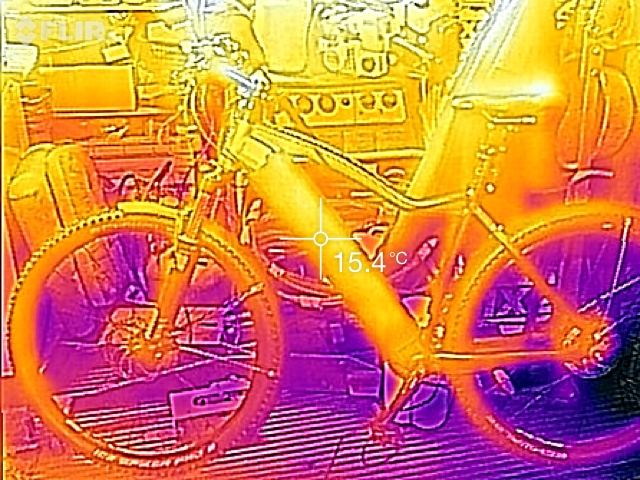
So here the battery has been charging for two hours with the cover on, from three bars to five, and is probably trickle charging by the time I took the pictures. Bike is at ambient 15 C. Charger red light still on, so charging.
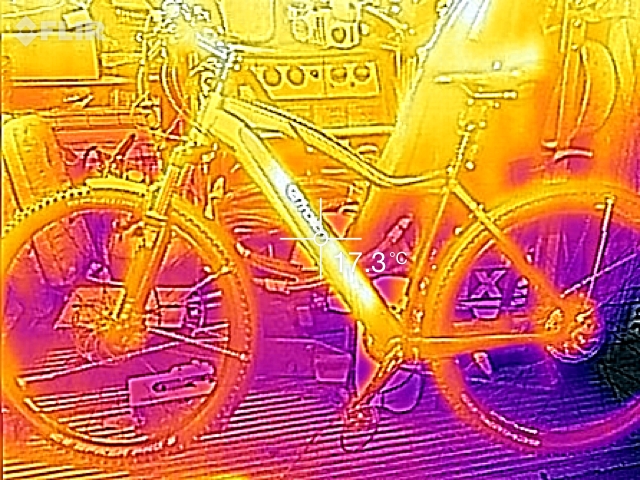
And here I took the cover off: 17,3 C. Only a 2 degree gain over ambient, so it seems like the battery is OK to charge at mild ambient temperatures even with overkill insulation surrounding it. Though keep in mind, the BH Evo charger is only 2 Amps at 36V for a 430Wh battery which makes for a slow charge, and very little current gets converted to resistive heat inside the cells. A fast charging power tool battery might just burst into flames covered up like that.
I'll have to try room temperatures (22 C) at a later date.
----------------------------------------------
Longer ride. After charging the battery and letting the bike sit for 30min without the cover, to get rid of some of the charging heat, I took off for a longer 27km ride in +1 C weather, Sport assist. I rode 12km, took a 15min stop, rode 3km, took a 10min stop, then rode back 12km. So the bike was outdoors in +1 C for 27km and ~90 minutes. This would simulate a shopping run etc.
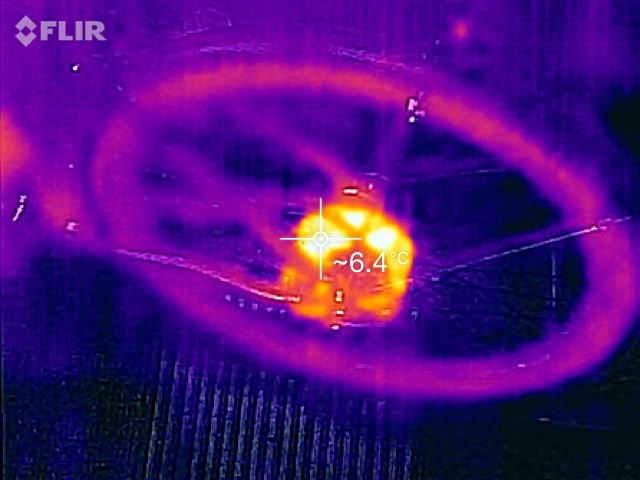
Again, motor immediately after the ride, outdoors pic. Reading is inaccurate, but obviously some heat generated and sustained by the motor even after a long ride, so definitely not just residual indoor ambient heat stored in the dense mass of the motor.
Cool is good for electric motors, but I wonder how the plastic planetary gears do at even lower temperatures, like -20 C.
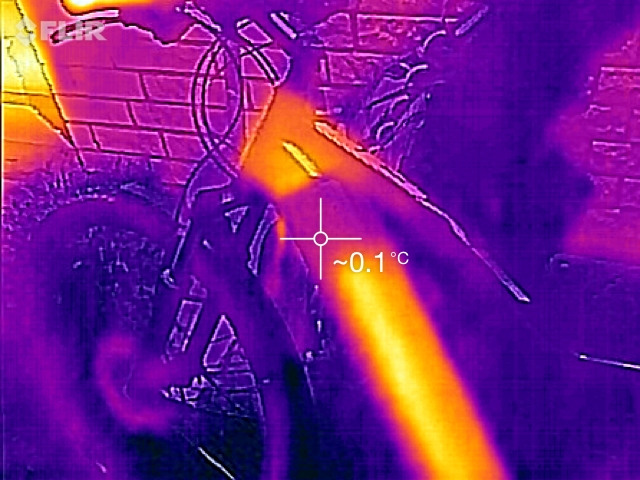
Still immediately after the 27km ride, outdoors, cover still on. Note the heat transfer towards the headset. The controller, which puts out some heat too, sits inside the frame right where the reticle is (the 13mm Armaflex wraps around it too), and some of the battery heat might be spreading up the frame too, though the "hot" areas are only about 2-3 C. Some heat is pushing through the cover, forming the shape of the battery.
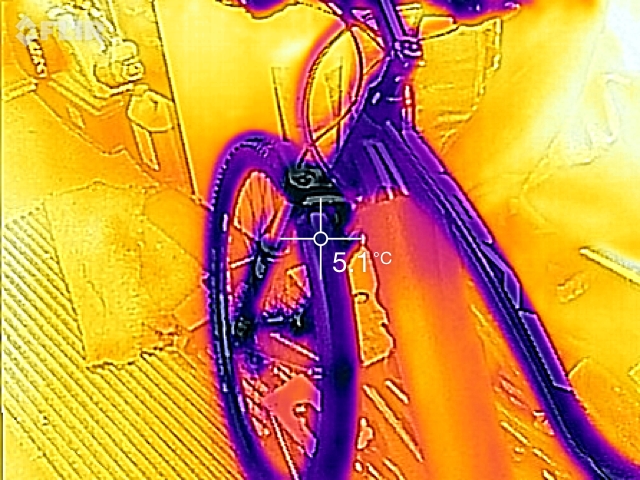
Indoors again, targeting a reference point on the fender. Cover still on. The surface of the cover reaches ambient temperature very quickly, being foam insulation with very low mass and density. The shiny stanchions are not instantly at ambient temp though, but reflect the thermal infrared of the surroundings like mirrors.
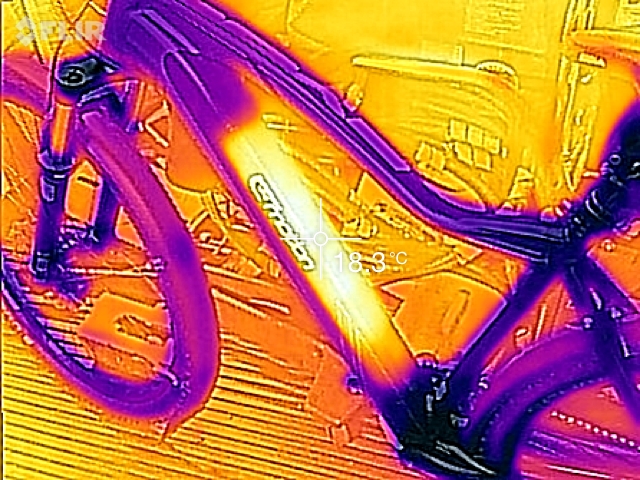
Cover off. Almost right on the money compared to my earlier short 7km run: 18,3 C. So stopping briefly or taking a long ride will not kill the battery temperature so long as the current draw (resistive heat), thickness of insulation and outdoor ambient temperature meet optimally, and the battery temperature neither plunges nor climbs. Near 20 C is the optimal operating temperature for many li-ion batteries, and is achieved here by pure coincidence.
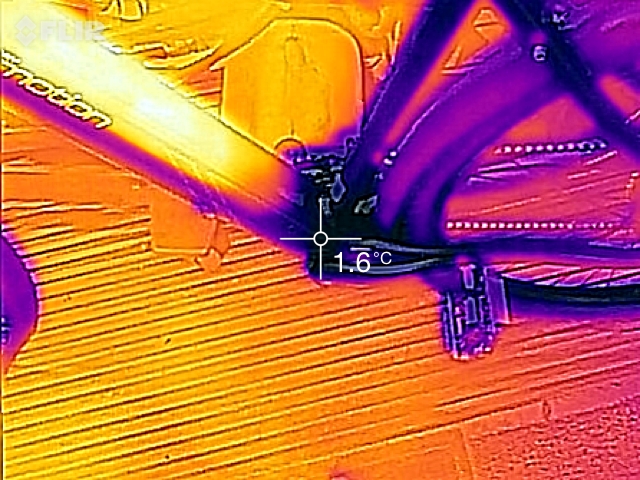
The bottom bracket seems to be one of the coldest spots on the bike. Possibly due to mass and the cable holes on the underside that let cold air circulate within the frame.
UPDATED with official BH Easy Motion neoprene Winter Cover measurements:
I've now had the official BH neoprene winter cover for a few months, and here are some results. I've formatted the pictures to be more at-a-glance instead of uploading each FLIR photo individually.
Background for each result:
-Typically 12km (7.5mi) / 30min commute ride, charging right before riding.
-Bike inside before ride, either room temp or lower garage temp.
-Boost or Sport mode (max assist level, 250W Controller, 350W US-spec motor).
-Official BH Winter Cover on during charging and riding, only taking it off to measure battery surface temperature.
The results are far better than I expected. The neoprene cover performs excellently under conditions where the battery is drained quickly and the resulting current draw / resistive discharge heat together with the stored ambient heat is preserved, but the battery still doesn't seem to reach harmful temperatures either. The resulting battery temperature does seem to correlate with outside ambient temperature, but not nearly as dramatically as I expected. The end result between +2 deg C and -19 deg C weather is only 4 degrees C in battery temperature (37 deg F differential yields 10 deg F variance).
Charging with the cover on at room temperature and at 2 Amperes (36V) is perfectly safe, only a minor difference between ambient and battery temperature can be (superficially) observed after hours of charging. So there's no need to take the cover off at all during the winter months, except for washing the bike or to remove the battery.

20th Oct 2016

21st Oct 2016

7th November 2016

7th January 2017
----------------------------------------------
Older CUSTOM cover measurements:
Using my custom 13mm Armacell cover, +3 deg C weather, 7km trip. Starting temp (ambient) of the bike was about 15 C. Battery at full charge, not charged for two days (so NO residual charging heat or gain). "Sport" assist. After the ride:

Motor temp immediately after ride, outdoor pic. For reference, the bike frame and wheel should be around +4 C here, and the ground is subzero (actually ice). Reading might be inaccurate.

A minute later, bike indoors, cover still on, warming up towards ambient temp (15C). Fenders are matted plastic just like the battery, for emissivity, scale and reference. Though this won't be an exact science.

Cover off, battery temp (gain?) 17.7 C, clearly warmer than ambient. Notice how the underside of the alloy downtube has transferred the outdoor ambient temp almost uniformly down the frame, despite the thick protective cover. So the downtube is a bit of a heatsink for the battery, though the rubber pads on the battery and the gap between the battery shell and the bike frame should help isolate the battery from the cooler frame.
-----------------------------
I let the bike reach ambient temp again between rides. Second ride just like the first (+3C and 7km, Sport assist), but this time without the cover:

Battery temp much lower. Readings not super accurate due to lack of calibration cycles. Battery temp mostly residual indoor thermal energy due to battery mass and short ride, not as much resistive heat? Notice colder section towards the lower end of the battery, this houses the battery management system (BMS) board and circuitry, so mostly empty space, the groups of 18650 cells are above it.

Reticle on plastic fenders, for reference.
-----------------------------------
UPDATE: Second day of testing.
I wanted to see if it's bad for the battery to keep the 13mm cover on while charging, causing it to overheat. Keep in mind, the official cover would only be 3mm neoprene, so way less insulation.

So here the battery has been charging for two hours with the cover on, from three bars to five, and is probably trickle charging by the time I took the pictures. Bike is at ambient 15 C. Charger red light still on, so charging.

And here I took the cover off: 17,3 C. Only a 2 degree gain over ambient, so it seems like the battery is OK to charge at mild ambient temperatures even with overkill insulation surrounding it. Though keep in mind, the BH Evo charger is only 2 Amps at 36V for a 430Wh battery which makes for a slow charge, and very little current gets converted to resistive heat inside the cells. A fast charging power tool battery might just burst into flames covered up like that.
I'll have to try room temperatures (22 C) at a later date.
----------------------------------------------
Longer ride. After charging the battery and letting the bike sit for 30min without the cover, to get rid of some of the charging heat, I took off for a longer 27km ride in +1 C weather, Sport assist. I rode 12km, took a 15min stop, rode 3km, took a 10min stop, then rode back 12km. So the bike was outdoors in +1 C for 27km and ~90 minutes. This would simulate a shopping run etc.

Again, motor immediately after the ride, outdoors pic. Reading is inaccurate, but obviously some heat generated and sustained by the motor even after a long ride, so definitely not just residual indoor ambient heat stored in the dense mass of the motor.
Cool is good for electric motors, but I wonder how the plastic planetary gears do at even lower temperatures, like -20 C.

Still immediately after the 27km ride, outdoors, cover still on. Note the heat transfer towards the headset. The controller, which puts out some heat too, sits inside the frame right where the reticle is (the 13mm Armaflex wraps around it too), and some of the battery heat might be spreading up the frame too, though the "hot" areas are only about 2-3 C. Some heat is pushing through the cover, forming the shape of the battery.

Indoors again, targeting a reference point on the fender. Cover still on. The surface of the cover reaches ambient temperature very quickly, being foam insulation with very low mass and density. The shiny stanchions are not instantly at ambient temp though, but reflect the thermal infrared of the surroundings like mirrors.

Cover off. Almost right on the money compared to my earlier short 7km run: 18,3 C. So stopping briefly or taking a long ride will not kill the battery temperature so long as the current draw (resistive heat), thickness of insulation and outdoor ambient temperature meet optimally, and the battery temperature neither plunges nor climbs. Near 20 C is the optimal operating temperature for many li-ion batteries, and is achieved here by pure coincidence.

The bottom bracket seems to be one of the coldest spots on the bike. Possibly due to mass and the cable holes on the underside that let cold air circulate within the frame.
Last edited:
